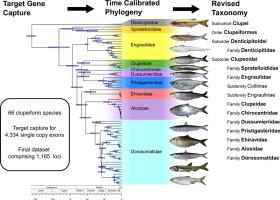Molecular Phylogenetics and Evolution ( IF 3.6 ) Pub Date : 2022-07-16 , DOI: 10.1016/j.ympev.2022.107590 Qian Wang 1 , Leyli Purrafee Dizaj 2 , Junman Huang 3 , Kishor Kumar Sarker 3 , Charalampos Kevrekidis 4 , Bettina Reichenbacher 5 , Hamid Reza Esmaeili 2 , Nicolas Straube 6 , Timo Moritz 7 , Chenhong Li 3

|
The Clupeiformes, including among others herrings, anchovies, shads and menhadens are ecologically and commercially important, yet their phylogenetic relationships are still controversial. Previous classification of Clupeiformes were based on morphological characters or lack of synapomorphic characters. More recent studies based on molecular data as well as new morphological evidence are keeping challenging their phylogenetic relations and there is still no consensus on many interrelationships within the Clupeiformes. In this study, we collected nuclear sequence data from 4,434 single-copy protein coding loci using a gene-capture method. We obtained a robust phylogeny based on 1,165 filtered loci with less than 30 % missing data. Our major findings include: 1) reconfirmation of monophyly of the Clupeiformes, that is, Denticipitidae is sister to all other clupeiforms; 2) the polyphyletic nature of dussumieriids and early branching of Spratelloididae from all other clupeoids were confirmed using datasets curated for less missing data and more balanced base composition in the respective taxa. The next branching clade is the monophyletic Engraulidae. Pristigasteridae also is monophyletic, but it was nested in the previously defined “Clupeidae”. Within Pristigasteridae there is no support for monophyletic Pelloninae. Chirocentrus is close to Dussumieria and not to engraulids. The miniaturized Sundasalanx is placed close to the ehiravine Clupeonella, however, with a relatively deep split. The genus Clupea, is not part of the diverse “Clupeidae”, but part of a clade containing additionally Sprattus and Etrumeus. Within the crown group clades, Alosidae and Dorosomatidae are retrieved as sister clades. Based on new fossil calibration points, we found that major lineages of the clupeiforms diverged in the late Cretaceous and early Paleogene. The extinction event at the end of the Cretaceous may have created ecological niches, which could have fueled the diversification of clupeiform fishes. Based on the strong evidence of the present study, we propose an updated classification of Clupeiformes consisting of ten families: Denticipitidae; Spratelloididae; Engraulidae (Engraulinae + Coiliinae); Clupeidae; Chirocentridae; Dussumieriidae; Pristigasteridae; Ehiravidae; Alosidae, Dorosomatidae.
中文翻译:

基于外显子捕获数据的鲱形目分子系统发育和目的新分类
鲱鱼、鲱鱼、鲱鱼和鲱鱼等鲱鱼在生态和商业上都很重要,但它们的系统发育关系仍然存在争议。以前的 Clupeiformes 分类是基于形态特征或缺乏突触特征。最近基于分子数据和新的形态学证据的研究不断挑战它们的系统发育关系,对于鲱形目内部的许多相互关系仍然没有达成共识。在这项研究中,我们使用基因捕获方法从 4,434 个单拷贝蛋白质编码位点收集了核序列数据。我们基于 1,165 个过滤基因座获得了稳健的系统发育,缺失数据少于 30%。我们的主要发现包括:1)重新确认鲱形目单一系,即 Denticipitidae 是所有其他 clupeiforms 的姐妹;2) dussumieriids 的多系性和所有其他 clupeoids 的 Spratelloididae 的早期分支通过使用为减少缺失数据和在各个分类群中更平衡的碱基组成而整理的数据集得到证实。下一个分支进化枝是单系 Engraulidae。Pristigasteridae 也是单系的,但它嵌套在先前定义的“Clupeidae”中。在 Pristigasteridae 中,不支持单系 Pelloninae。但它嵌套在之前定义的“Clupeidae”中。在 Pristigasteridae 中,不支持单系 Pelloninae。但它嵌套在之前定义的“Clupeidae”中。在 Pristigasteridae 中,不支持单系 Pelloninae。Chirocentrus靠近Dussumieria而不是 engraulids。小型化的Sundasalanx靠近 ehiravine Clupeonella放置,然而,分裂相对较深。鲱属不是多样化的“鲱科”的一部分,而是另外包含斯普拉图斯和埃特鲁姆斯的进化枝的一部分. 在冠群进化枝中,Alosidae 和 Dorosomatidae 作为姐妹进化枝被检索到。基于新的化石校准点,我们发现在白垩纪晚期和古近纪早期,clupeiforms的主要谱系发生了分歧。白垩纪末期的灭绝事件可能创造了生态位,这可能推动了鱼类的多样化。基于本研究的有力证据,我们提出了由十个科组成的Clupeiformes的更新分类:Denticipitidae;鳖科; Engraulidae(Engraulinae + Coiliinae);鲶科; 手足科; 杜鹃科; 鲶科; 埃希拉维科;鼯鼠科,鼯鼠科。































 京公网安备 11010802027423号
京公网安备 11010802027423号